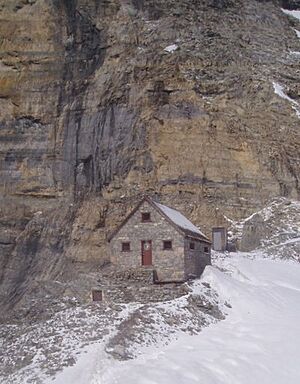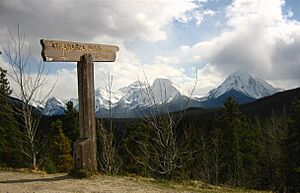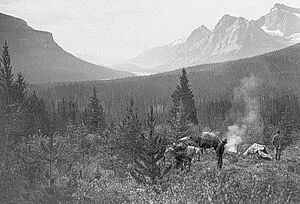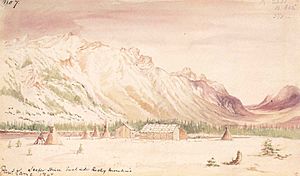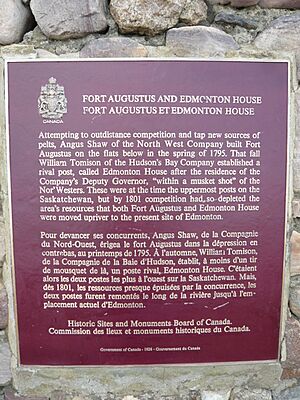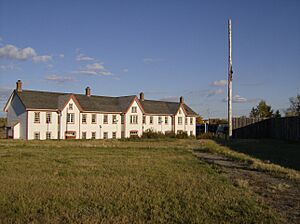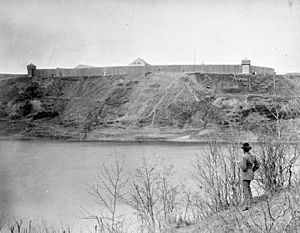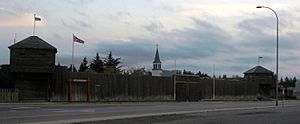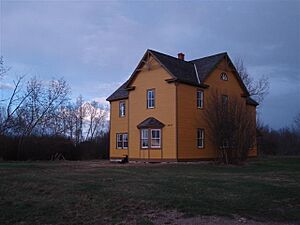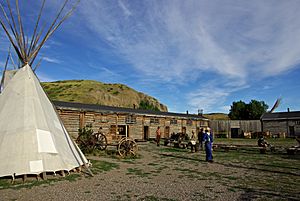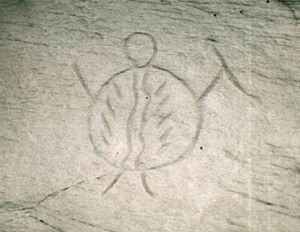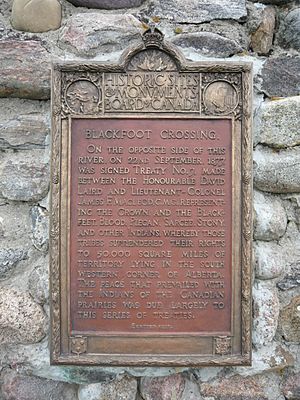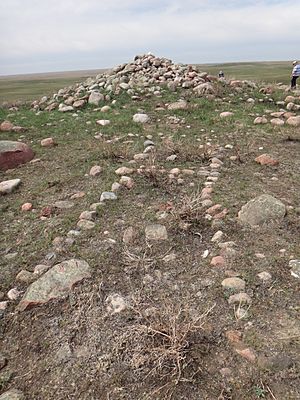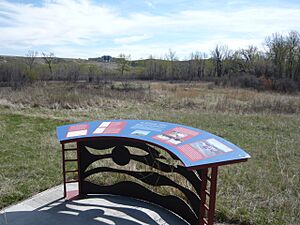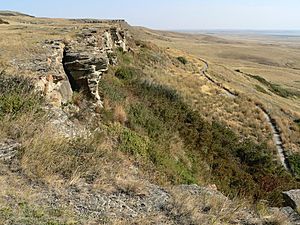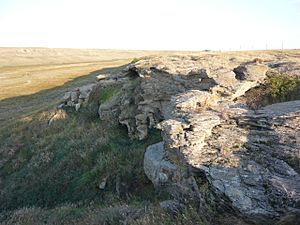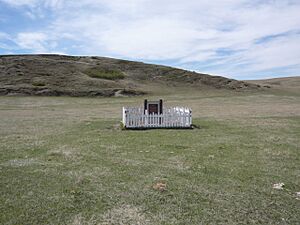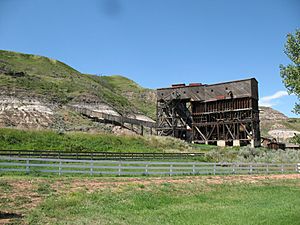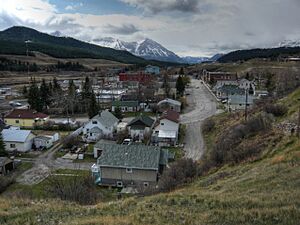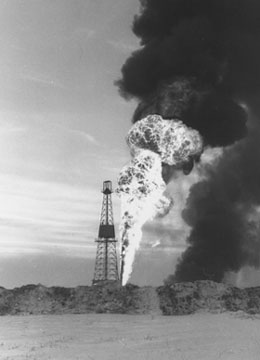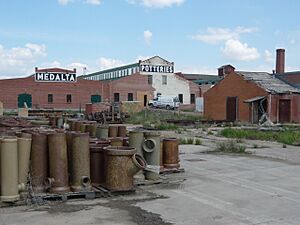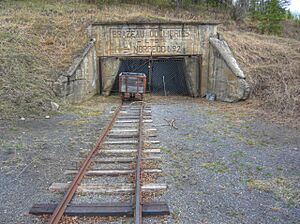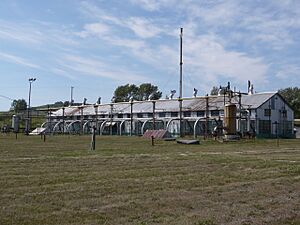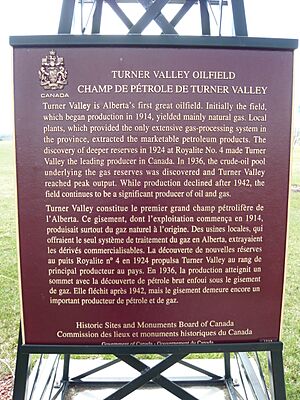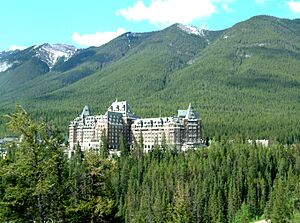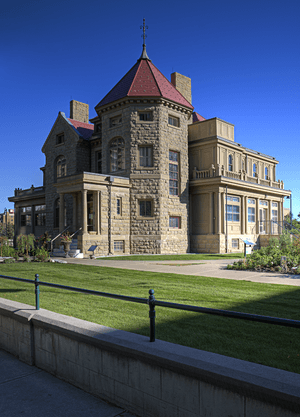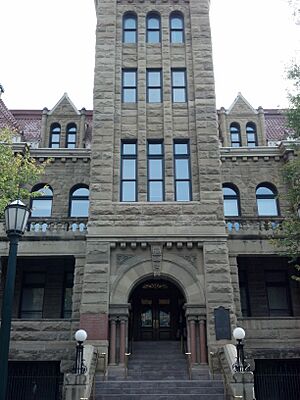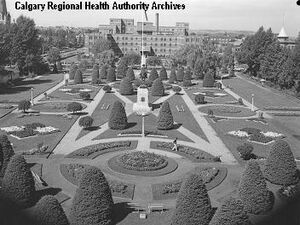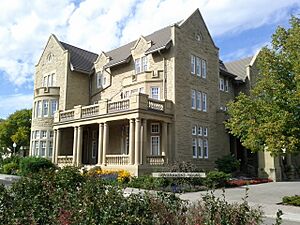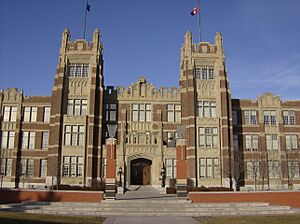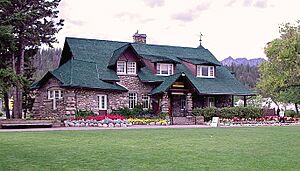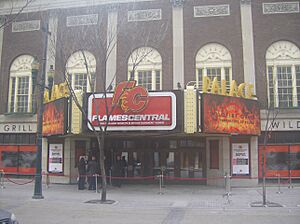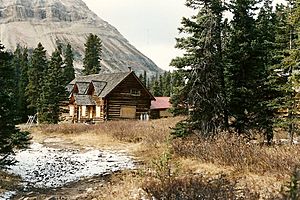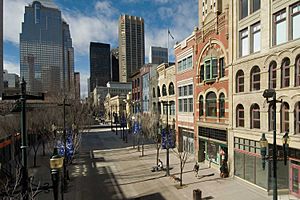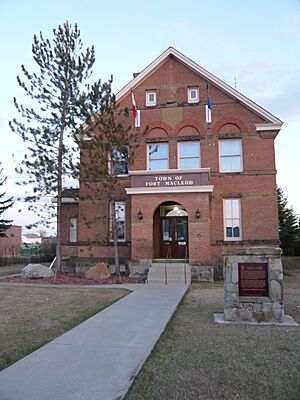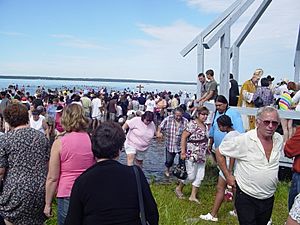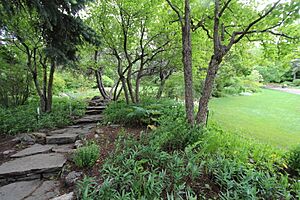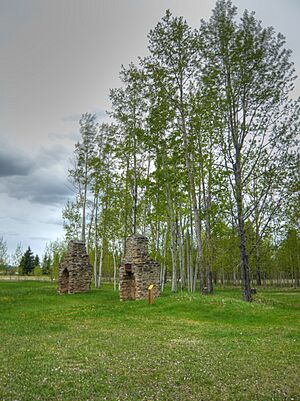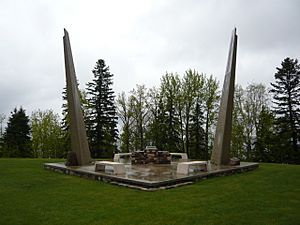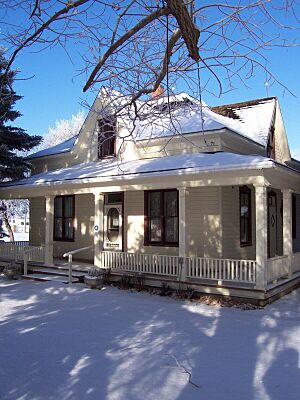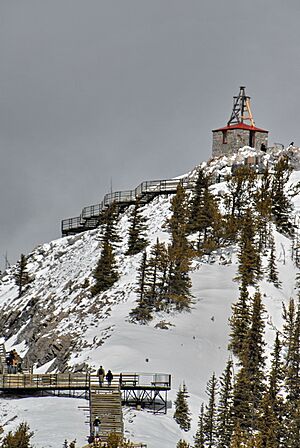List of National Historic Sites of Canada in Alberta facts for kids
As of March 2018, Alberta is home to 61 special places called National Historic Sites. These are important locations that tell us about Canada's past. Sixteen of these sites are looked after by Parks Canada, a government agency that protects natural and historical places.
The first three sites in Alberta were chosen way back in 1923. These included the spots where two rival fur trading posts, Fort Augustus and Fort Edmonton, once stood. Another was the site of the Frog Lake Massacre, a sad event from 1885. The third was the first outpost of the North-West Mounted Police (who later became the RCMP) in Western Canada, located at Fort Macleod.
Many other important events and people from Canadian history are also remembered across Alberta. You can find special plaques marking these spots, just like the ones for National Historic Sites.
Contents
- Discovering Alberta's Historic Sites
- Mountain and Fur Trade History
- Early Settlements and Forts
- Indigenous Heritage Sites
- Industrial and Economic Landmarks
- Buildings and Architecture
- Banff Park Museum
- Banff Springs Hotel
- Beaulieu (Lougheed House)
- Calgary City Hall
- Central Memorial Park and Library
- Government House in Edmonton
- Heritage Hall - Southern Alberta Institute of Technology
- Jasper Park Information Centre
- Mewata Drill Hall / Calgary Drill Hall
- Palace Theatre
- Prince of Wales Hotel
- Skoki Ski Lodge
- St. Patrick's Roman Catholic Church
- Stephen Avenue
- Temple of the Church of Jesus Christ of Latter Day Saints
- Territorial Court House
- Wetaskiwin Court House
- Other Important Sites
- Former National Historic Sites in Alberta
- See also
Discovering Alberta's Historic Sites
![]() This symbol means the site is managed by Parks Canada.
This symbol means the site is managed by Parks Canada.
Here's a look at some of Alberta's amazing National Historic Sites:
Mountain and Fur Trade History
Abbot Pass Refuge Cabin
This mountain hut was finished in 1922. It sits very high up, at 2,925 meters (about 9,600 feet) in the Alberta Rockies. It's located in Banff National Park, right near the border with Yoho National Park in British Columbia. It was named a historic site in 1992.
Athabasca Pass
First explored by non-Indigenous people in 1811, this mountain pass was a super important route for the fur trade. It connected different parts of Canada and was used by traders traveling between Rupert's Land and the Columbia District. It became a historic site in 1971.
Howse Pass
This pass was an early travel route through the Canadian Rockies in the early 1800s. The Ktunaxa First Nation also used it for centuries to reach buffalo herds on the plains. It was recognized as a historic site in 1978.
Jasper House
These are the remains of an old fur trade post built in 1830. It was a key stop for travelers using the Athabasca Pass and Yellowhead Pass. It also served First Nations people traveling through the Smoky River Pass. It became a historic site in 1924.
Yellowhead Pass
This pass through the Canadian Rockies has been an important travel route for centuries. First Nations people used it, as did the Hudson's Bay Company and later, railway companies. It was designated a historic site in 1971.
Early Settlements and Forts
Fort Augustus and Fort Edmonton
These were rival fur trading posts built in 1795 and 1796. One was run by the North West Company and the other by the Hudson's Bay Company. They were so close, people said they were just a "musket-shot" apart! This site became historic in 1923.
Fort Calgary
Established in 1875, this fort was built by the North-West Mounted Police. It's located where the Bow and Elbow rivers meet in what is now Calgary. It was named a historic site in 1925.
Fort Chipewyan
This is one of the oldest European settlements in Alberta, started in 1788 by the North West Company as a trading post. It became a historic site in 1930.
Fort Dunvegan
Established in 1805, this trading post was also built by the North West Company. It was the most important trading spot in the Peace River Valley and a key part of the fur trade network. It was recognized as a historic site in 1947.
Fort Edmonton III
This was the last Hudson's Bay Company fort to be called "Fort Edmonton," and it grew into the city of Edmonton we know today. A reconstructed version of the fort is part of Fort Edmonton Park. It became a historic site in 1959.
Fort Fork
Established in 1792, this fort was the starting point for explorer Alexander MacKenzie's journey to the Pacific Ocean in 1793. It was named a historic site in 1928.
Fort Macleod
This fort was set up in 1874 on an island in the Oldman River. It was the very first outpost for the North-West Mounted Police in Western Canada and served as their main office from 1874 to 1878. It became a historic site in 1923.
Fort Vermilion
The "Old Bay House" here is the only Hudson's Bay Company factor's house still standing in its original spot in Alberta. It's the last building from the fort that grew into the modern hamlet of Fort Vermilion. It was designated a historic site in 1968.
Fort Whoop-Up
Originally called Fort Hamilton, this trading post became a center for the illegal whisky trade around 1870. This led to the creation of the North-West Mounted Police in 1874 to bring order to Canada's western lands. It became a historic site in 1963.
Victoria Settlement
Established in 1863, this area shows how the Canadian Prairies developed. It includes the fur trade, the Métis river lot system, the arrival of missions, farming, and the settlement of Eastern European immigrants. It was named a historic site in 2001.
Indigenous Heritage Sites
Áísínai'pi (Writing-on-Stone Provincial Park)✝
This special place, also known as Writing-on-Stone Provincial Park, protects many ancient Indigenous rock carvings and paintings. It's also a nature preserve. It became a historic site in 2004 and is a UNESCO World Heritage Site.
Blackfoot Crossing
This was a traditional meeting place for the Blackfoot people. In 1877, representatives from the Crown (the government) and the Siksika, Northern Peigan, Kainai, Nakoda, and Tsuu T'ina peoples met here to sign Treaty 7. It was designated a historic site in 1925.
British Block Cairn
This large pile of rocks, surrounded by a stone ring, dates back to around 1400 CE. It's an important example of Niitsitapi (Blackfoot) cultural heritage. It became a historic site in 1973.
Earthlodge Village
These unique defensive earthworks, built around 1740 by an unknown people, are found nowhere else in Canada. They were recognized as a historic site in 1972.
Head-Smashed-In Buffalo Jump✝
This famous buffalo jump was used for 5,500 years by Indigenous peoples of the plains to hunt buffalo. They would drive the buffalo off an 11-meter-high (about 36-foot) cliff. It's a UNESCO World Heritage Site and became a historic site in 1968.
Old Women's Buffalo Jump
This ancient buffalo jump was used by Indigenous people for about 2,000 years. It's a visually striking and important example of how buffalo were hunted in the past. It was named a historic site in 1960.
Suffield Tipi Rings
These are various archaeological remains from the Niitsitapi (Blackfoot) people. They include tipi rings, medicine wheels, and other stone arrangements. They were recognized as a historic site in 1973.
Treaty Nº 7 Signing Site
This is the exact spot where representatives of the Siksika, Pekuni, Kainai, Nakoda, and Tsuu T'ina peoples met with the Crown (the government) to sign Treaty 7 in September 1877. It became a historic site in 1925.
Industrial and Economic Landmarks
Atlas No. 3 Coal Mine
Opened in 1936, this mine is an incredibly well-preserved example of a coal-mining site. It played a huge role in the history of coal in the Drumheller Valley, which was the most productive coalfield in Alberta. It was designated a historic site in 2001.
Brooks Aqueduct
Completed in 1914, this impressive irrigation project was built by the Canadian Pacific Railway. It spans a 3.2-kilometer (2-mile) valley and helped water a large part of southeastern Alberta. It became a historic site in 1983.
Coleman
Established in 1903, Coleman is a well-preserved coal-mining town. It was one of the most important coal-producing areas in the Crowsnest Pass, a major coalfield in Alberta and British Columbia. It was recognized as a historic site in 2001.
First Oil Well in Western Canada
This was the first oil well in Western Canada that produced oil for sale, discovered in 1902. Even though it dried up in 1904, it showed that much larger oil fields were present, leading to future discoveries. A monument was built here in 1968. It became a historic site in 1965.
Leduc-Woodbend Oilfield
This site marks a huge crude oil discovery in Alberta in 1946. This discovery led to a massive boom in petroleum exploration and development in Western Canada after World War II. It was designated a historic site in 1990.
Medalta Potteries
Established in 1912, this site features early 20th-century beehive kilns and factory buildings. It was the first manufacturer in Western Canada to ship its products east of the Great Lakes. It became a historic site in 1985.
Medicine Hat Clay Industries
This area shows how Medicine Hat became the biggest supplier of clay products west of Ontario. It had local clay, railway access, and lots of natural gas to fire the kilns. It was recognized as a historic site in 1999.
Nordegg
The mine here was established in 1911. Nordegg is an important coal mining area, with many mining buildings and related resources still existing on site. It was designated a historic site in 2001.
Turner Valley Gas Plant
This industrial complex, established in 1914, has 22 metal buildings and other structures. It's the site of two early gas wells that made Turner Valley the most important oil field in Alberta. It became a historic site in 1995.
Turner Valley Oilfield
This was Alberta's first major oil field, established in 1914. It had the only extensive gas-processing system in the province for a long time. It was Canada's leading oil producer in 1924 and reached its peak in 1936. It was recognized as a historic site in 1990.
Buildings and Architecture
Banff Park Museum
Completed in 1903, this rustic log building is in a beautiful park in Banff. It holds early plant and animal exhibits from Banff National Park in old glass cases. It became a historic site in 1985.
Banff Springs Hotel
This former railway hotel was finished in 1928. It's built in a Scottish Baronial style at the base of Sulphur Mountain. It replaced an older wooden hotel that burned down. It was designated a historic site in 1988.
Beaulieu (Lougheed House)
Known as Lougheed House, this grand mansion in Calgary was completed in 1891. It was originally built for Senator James Alexander Lougheed. It became a historic site in 1992.
Calgary City Hall
This four-story sandstone building with a central clock tower was finished in 1911. It's designed in the Romanesque Revival style and is the main part of Calgary's city hall complex. It was recognized as a historic site in 1984.
Central Memorial Park and Library
This park, established in 1889, features formal gardens, memorials, and a striking Carnegie library. It symbolizes Calgary's desire to become a beautiful and cultured city in the West. It became a historic site in 2018.
Government House in Edmonton
Completed in 1911, this building served as the official home for Alberta's first six Lieutenant Governors. Its impressive look and unique design show Alberta's new status as a province and Edmonton's role as the capital. It was designated a historic site in 2012.
Heritage Hall - Southern Alberta Institute of Technology
Finished in 1922, this three-story educational building sits proudly on a hill overlooking the Bow River valley. Its Collegiate Gothic style shows the growth of post-secondary education in Canada in the early 20th century. It became a historic site in 1987.
Jasper Park Information Centre
This rustic stone building, completed in 1914, is a symbol of early architecture in Canada's national parks. It was recognized as a historic site in 1992.
Mewata Drill Hall / Calgary Drill Hall
This large drill hall, completed in 1918, shows the national pride felt after Canada's strong performance in the South African War and First World War. It was designated a historic site in 1989.
Palace Theatre
Completed in 1921, this movie palace was designed by a famous theatre architect. It's one of only four such movie theatres built by the Allen Chain that still exist in Canada. It became a historic site in 1996.
Prince of Wales Hotel
This landmark hotel, finished in 1927, is built in a rustic style. It represents the "golden age" of railway resort development in Canada's national parks. It was recognized as a historic site in 1992.
Skoki Ski Lodge
This rustic ski lodge, completed in 1936, shows the early look of Canada's mountain parks and the beginnings of tourism in Banff National Park. It was designated a historic site in 1992.
St. Patrick's Roman Catholic Church
Completed in 1914, this church is a great example of Gothic Revival architecture in Alberta. Its modern materials and unique design combine early 20th-century style with French Gothic details. It became a historic site in 1990.
Stephen Avenue
This retail street in downtown Calgary, established in the 1880s, tells the story of city growth on the prairies. It shows how important retail became and how architectural styles changed from the late 1800s to the 1930s. It was recognized as a historic site in 2002.
Temple of the Church of Jesus Christ of Latter Day Saints
Completed in 1923, this grand modern temple in Cardston was very different from other Mormon temple designs of its time. It's known for its high-quality materials and amazing craftsmanship. It was designated a historic site in 1992.
Territorial Court House
Finished in 1904, this is the oldest court house in Alberta. It's one of the few buildings left from the time when the Canadian Prairies were still territories. It became a historic site in 1980.
Wetaskiwin Court House
Completed in 1909, this court house shows the fast growth of the justice system in Alberta. It's a typical example of court house design during this important time in Western Canada's development. It was recognized as a historic site in 1980.
Other Important Sites
Cave and Basin
First documented by non-Indigenous people in 1859, this site has natural thermal mineral springs. Canada's first national park, Banff National Park, was created around these springs. It became a historic site in 1981.
Lac Ste. Anne Pilgrimage
Established in 1889, this was the first Roman Catholic mission started by the famous priest, Albert Lacombe. It was recognized as a historic site in 1984.
Reader Rock Garden
This scientific and artistic garden was started in 1913 by William R. Reader. It's designed in the Arts and Crafts style and shows what's possible for gardening in Calgary. It's admired for its beauty and many different plants. It became a historic site in 2018.
Rocky Mountain House
This archaeological site, established in 1799, holds the remains of several early 19th-century fur trade forts. These forts were known as Rocky Mountain House (built by the North West Company) and Acton House (built by the Hudson's Bay Company). It was designated a historic site in 1926.
Rundle's Mission
Established in 1847, this was the first Protestant mission in the Canadian Prairies. It was started by Reverend Robert Terrill Rundle and operated until 1906. It became a historic site in 1963.
Stirling Agricultural Village
Established in 1899, this is the best example of a Mormon farming village in Canada that still follows the original "Plat of Zion" design. It was recognized as a historic site in 1997.
Sulphur Mountain Cosmic Ray Station
Completed in 1957, this was a laboratory near the top of Sulphur Mountain in Banff National Park. It was Canada's most important cosmic ray observatory in the 1950s, helping us understand how the sun affects Earth. It became a historic site in 1982.
Former National Historic Sites in Alberta
Some sites that were once considered National Historic Sites in Alberta have since changed status:
- Cochrane Ranch National Historic Site (1968-1988): It was later decided that this site was not important enough to be a national historic site.
- Laggan Canadian Pacific Railroad Station National Historic Site (disbanded 1976): The original station was taken down, but it was rebuilt at Heritage Park Historical Village.
- Flying-E Ranch National Historic Site (1974-1988): This site was also later deemed not to be of national historic significance.
See also
- History of Alberta
- List of historic places in Alberta
- Provincial historic sites of Alberta


